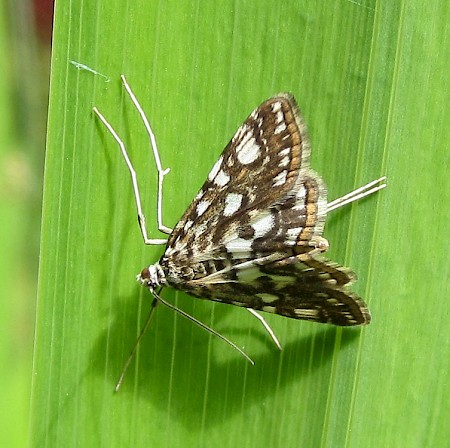63.114 BF1345
Brown China-mark Elophila nymphaeata
(Linnaeus, 1758)
[Synonyms: Nymphula nymphaeata]Wingspan 22-30 mm.
The group of moths known as China-marks are unusual in that their larvae are entirely aquatic, feeding on water plants.
This species is quite variable, and some examples are quite dark and dull-looking, whereas others can have delicately-patterned white patches and streaks.
The moth flies in July and August, and the species is fairly common around ponds, lakes and canals throughout Britain.
- More details (Description: Ian F. Smith):
Larva:
Foodplant: All year, July - June, on leaves of Potamogeton. Also on other aquatic plants, such as Sparangium spp.and Hydrocharis. First instar in gallery mine. Thereafter, larva either in a free bivalved case of two ovals of leaf material, or under an oval cover of excised leaf material on the underside of the leaf. In winter, the larva is in a gelatinous hibernaculum within the latter habitation, even if the leaf is decaying and submerged.Over-wintering larva:
Length: larva about 7 mm, case about 12mm. Head: Shagreened brown ochre. Frons paler. Epicranial spheres finely edged blackish. Mouthparts reddish brown. Stemmata black, connected by curved blackish band.
Prothorax (T1): Anterior border whitish translucent and shagreened. Prothoracic shield strongly shagreened olive-brown ochre, surrounded by broad blackish border. Divided by very fine faint pale medial line.
Thoracic legs: Translucent light brown.
Body: Shagreened, translucent dull yellowish green. When feeding, viscera visible as reddish brown dorsal line, and frass may show grey in posterior segments.
Spiracles: Very small. Peritreme black.
Pinacula: Indiscernible. Very fine dark setal spot. Setae: October; very fine, transparent almost colourless. February; brown basally, fading colourless distally.
Anal plate: As rest of abdomen with several brown spots which are barely discernible in October, but more visible in February.
Prolegs: Concolorous with body. Crochets prominent, dark brown. Arranged in two transverse rows capable of being closed together in a gripping line.Late instar larva Buckler shows body more brownish, and prothoracic shield with dark central area each side of medial line.

 UKMoths
UKMoths 












